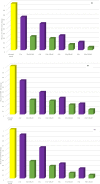Role of Resveratrol as Radiosensitizer by Targeting Cancer Stem Cells in Radioresistant Prostate Cancer Cells (PC-3)
- PMID: 34967561
- PMCID: PMC9080384
- DOI: 10.31557/APJCP.2021.22.12.3823
Role of Resveratrol as Radiosensitizer by Targeting Cancer Stem Cells in Radioresistant Prostate Cancer Cells (PC-3)
Abstract
Aim of work: Here, we examined the role of resveratrol as a radiosensitizer by targeting cancer stem cells in radioresistant prostate cancer cells (PC-3) using stem cell markers CD44, CD49b and CD29, SOX2, OCT4, CXCR4, DCLK1 and EMT markers such as VIM and E-cadherin.
Material and methods: This study was an in vitro study involving PC-3 cell line which was dividing into four groups. Group I (CO): Control group composed of cells grown in the same medium without treatment with ionizing radiation or resveratrol. Group II (IR): Cells were treated with ionizing radiation alone. Group III (RV): Cells were treated with resveratrol alone. Group VI (IR&RV): The cells were treated with ionizing radiation and resveratrol in combination. The viability of cells was assessed by MTT assay. Genes of interest were measured by RT-PCR and the radiosensitizing efficacy of RV on proliferating cancer cells was determined by clonogenic assay.
Results: Ionizing radiation significantly reduced PC-3 viability, lowered stem cell markers and affected epithelial to mesenchymal transition (EMT) genes expression at all doses (2, 4, 6 and 8 Gray). Resveratrol significantly decreased PC-3 viability and lowered stem cell markers and EMT genes expression at concentrations 35, 70 and 140 µM. Combining resveratrol treatment with ionizing radiation leads to significant reduction in cell viability and stem cell markers genes which was noticed with increasing the radiation dose when compared to ionizing radiation alone treated group.
Conclusion: Resveratrol has a radiosensitizing effect, that ability is triggered by reducing the expression of cancer stem cell markers and affecting EMT markers. Resveratrol showed to be a good candidate for further studies as anticancer drug in the treatment of human prostate cancer.
Keywords: DCLK1; epithelial mesenchymal transition; ionizing radiation.
Figures





Similar articles
-
A radiosensitizer, gallotannin-rich extract from Bouea macrophylla seeds, inhibits radiation-induced epithelial-mesenchymal transition in breast cancer cells.BMC Complement Med Ther. 2021 Jul 3;21(1):189. doi: 10.1186/s12906-021-03363-6. BMC Complement Med Ther. 2021. PMID: 34217266 Free PMC article.
-
Inhibitory action of pristimerin on hypoxia‑mediated metastasis involves stem cell characteristics and EMT in PC-3 prostate cancer cells.Oncol Rep. 2015 Mar;33(3):1388-94. doi: 10.3892/or.2015.3708. Epub 2015 Jan 7. Oncol Rep. 2015. PMID: 25571882
-
The Effect of Resveratrol and Quercetin on Epithelial-Mesenchymal Transition in Pancreatic Cancer Stem Cell.Nutr Cancer. 2020;72(7):1231-1242. doi: 10.1080/01635581.2019.1670853. Epub 2019 Oct 9. Nutr Cancer. 2020. PMID: 31595775
-
Markers of pancreatic cancer stem cells and their clinical and therapeutic implications.Mol Biol Rep. 2019 Dec;46(6):6629-6645. doi: 10.1007/s11033-019-05058-1. Epub 2019 Sep 5. Mol Biol Rep. 2019. PMID: 31486978 Review.
-
Natural Radiosensitizers in Radiotherapy: Cancer Treatment by Combining Ionizing Radiation with Resveratrol.Int J Mol Sci. 2022 Sep 13;23(18):10627. doi: 10.3390/ijms231810627. Int J Mol Sci. 2022. PMID: 36142554 Free PMC article. Review.
Cited by
-
Aspirin Restores Radiosensitivity in Cervical Cancer Cells by Inducing Mitotic Catastrophe through Downregulating G2/M Effectors.Asian Pac J Cancer Prev. 2022 Nov 1;23(11):3801-3813. doi: 10.31557/APJCP.2022.23.11.3801. Asian Pac J Cancer Prev. 2022. PMID: 36444593 Free PMC article.
-
Doublecortin-like kinase 1 promotes stem cell-like properties through the Hippo-YAP pathway in prostate cancer.Int J Med Sci. 2025 Jan 1;22(2):460-472. doi: 10.7150/ijms.99062. eCollection 2025. Int J Med Sci. 2025. PMID: 39781521 Free PMC article.
-
Cancer stem cells in personalized therapy: mechanisms, microenvironment crosstalk, and therapeutic vulnerabilities.Front Cell Dev Biol. 2025 Jul 30;13:1619597. doi: 10.3389/fcell.2025.1619597. eCollection 2025. Front Cell Dev Biol. 2025. PMID: 40809695 Free PMC article. Review.
-
Molecular mechanisms of resveratrol as chemo and radiosensitizer in cancer.Front Pharmacol. 2023 Nov 10;14:1287505. doi: 10.3389/fphar.2023.1287505. eCollection 2023. Front Pharmacol. 2023. PMID: 38026933 Free PMC article. Review.
-
Tissue-specific cancer stem/progenitor cells: Therapeutic implications.World J Stem Cells. 2023 May 26;15(5):323-341. doi: 10.4252/wjsc.v15.i5.323. World J Stem Cells. 2023. PMID: 37342220 Free PMC article. Review.
References
-
- Bonaccorsi L, Carloni V, Muratori M, et al. Androgen receptor expression in prostate carcinoma cells suppresses alpha6beta4 integrin-mediated invasive phenotype. Endocrinology. 2000;141:3172–82. - PubMed
MeSH terms
Substances
LinkOut - more resources
Full Text Sources
Medical
Research Materials
Miscellaneous

